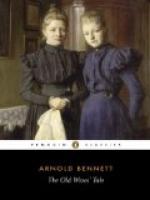And did Mrs. Baines encourage him in his single-minded enterprise on behalf of her business? Not a bit! Mrs. Baines’s attitude, when not disdainful, was inimical! So curious is human nature, so blind is man to his own advantage! Life was very complex for Mr. Povey. It might have been less complex had Bristol board and Chinese ink been less expensive; with these materials he could have achieved marvels to silence all prejudice and stupidity; but they were too costly. Still, he persevered, and Constance morally supported him; he drew his inspiration and his courage from Constance. Instead of the internal surface of collar-boxes, he tried the external surface, which was at any rate shiny. But the ink would not ‘take’ on it. He made as many experiments as Edison was to make, and as many failures. Then Constance was visited by a notion for mixing sugar with ink. Simple, innocent creature—why should providence have chosen her to be the vessel of such a sublime notion? Puzzling enigma, which, however, did not exercise Mr. Povey! He found it quite natural that she should save him. Save him she did. Sugar and ink would ‘take’ on anything, and it shone like a ‘patent leather’ boot. Further, Constance developed a ‘hand’ for lettering which outdid Mr. Povey’s. Between them they manufactured tickets by the dozen and by the score—tickets which, while possessing nearly all the smartness and finish of Mr. Chawner’s tickets, were much superior to these in originality and strikingness. Constance and Mr. Povey were delighted and fascinated by them. As for Mrs. Baines, she said little, but the modern spirit was too elated by its success to care whether she said little or much. And every few days Mr. Povey thought of some new and wonderful word to put on a ticket.
His last miracle was the word ‘exquisite.’ ‘Exquisite,’ pinned on a piece of broad tartan ribbon, appeared to Constance and Mr. Povey as the finality of appropriateness. A climax worthy to close the year! Mr. Povey had cut the card and sketched the word and figures in pencil, and Constance was doing her executive portion of the undertaking. They were very happy, very absorbed, in this strictly business matter. The clock showed five minutes past ten. Stern duty, a pure desire for the prosperity of the shop, had kept them at hard labour since before eight o’clock that morning!




